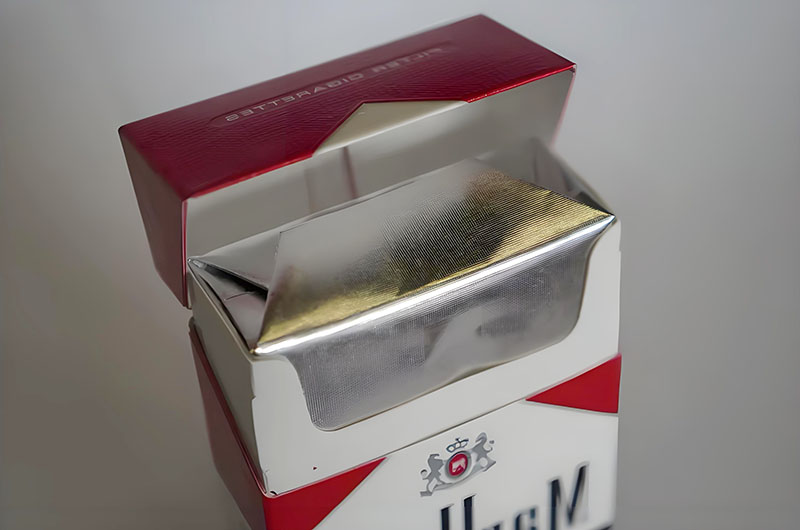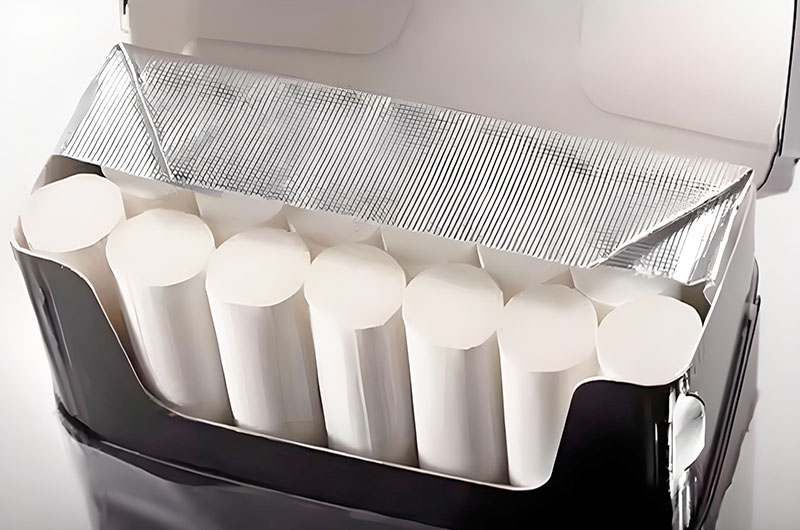Cigarette packaging aluminum foil is an important functional component in the cigarette industry. Its design and application involve a deep integration of material characteristics and industrial demands.

Cigarette Aluminum Foil Paper Structure
The aluminum foil used for cigarette packaging is typically an extremely thin layer of aluminum, with a thickness ranging from 8 to 12 microns. It is meticulously designed to be lightweight while offering excellent barrier properties. Sometimes, aluminum foil is laminated with other materials (such as polymer layers) to enhance durability, heat sealability, and resistance to moisture and oxygen.
Structure
Cigarette aluminum foil paper consists of an aluminum foil liner bonded with a paper backing, combining the barrier properties of metal with the flexibility of paper. The aluminum foil layer is typically 6.5-7 microns thick, soft in texture, and moldable to ensure the packaging conforms to the shape of the cigarette.
Cigarette Aluminum Foil Properties
- Barrier Protection: Aluminum foil blocks oxygen, moisture, and light. This ensures cigarettes remain fresh and retain their flavor and aroma for an extended period. Its reflective surface also helps maintain internal temperature by reflecting heat.
- Flexibility and Sealability: Due to its ductility, aluminum foil easily conforms to the shape of the cigarette, providing a tight seal that minimizes external contamination. This is crucial for maintaining product quality throughout its shelf life.
- Corrosion Resistance: Aluminum naturally forms a protective oxide layer, which helps resist corrosion. This makes it an ideal packaging material where product integrity is essential.
Cigarette Packaging Aluminum Foil Functions
- Moisture Resistance: Aluminum foil acts as an impermeable barrier to water vapor, preventing cigarettes from absorbing environmental moisture, which could degrade their quality. Laboratory tests have shown that aluminum foil lining can reduce moisture increase to <0.1% over three months, outperforming alternatives like paper or plastic.
- Oxygen Barrier: The dense molecular structure of aluminum foil prevents oxygen from entering, slowing oxidation reactions that could alter the burning characteristics. Compared to unlined packaging, the weight loss of cigarettes due to oxidation in foil-lined packaging is negligible.
- Freshness Preservation: By isolating moisture, oxygen, and UV light, aluminum foil helps maintain the aroma, flavor, and structural integrity of cigarettes throughout their shelf life.
- Odor Locking: The dense structure of aluminum foil prevents the escape of volatile organic compounds (VOCs), maintaining the stability of tobacco-specific aromatic components such as nicotine and tar.
Cigarette Packaging Aluminum Foil Material Specifications
- Alloy and Composition: Common alloys include 1235, 8011, and 8079.
- Thickness and Dimensions: Foil thickness typically ranges from 6 to 9 microns (0.006-0.009 mm), with strict tolerances (±3-5%) to ensure consistency in high-speed production lines.
- Standard widths range from 80 to 1700 mm and can be customized according to packaging machine requirements.
Surface Characteristics:
- A smooth, pore-free surface allows for high-resolution printing (e.g., lithographic printing, thermochromic inks) and special finishes (metallic gloss, embossing).
- One side is usually matte for lamination, while the other side is glossy for branding.
Quality Control: The number of pinholes is strictly regulated (e.g., ≤200 pinholes per square meter for 7-micron foil) to maintain barrier effectiveness.
Dimensional stability (e.g., roll width tolerance of ±1-2 mm) ensures compatibility with automated packaging systems.
Certifications: Compliance with ISO 9001, FCC food contact standards, and lead-free certification is mandatory for global supply chains.
Why Use Aluminum Foil for Cigarette Packaging?
Barrier Performance
Moisture Barrier: Aluminum foil provides excellent moisture barrier properties, keeping the cigarettes dry. Moisture can cause cigarettes to mold or deteriorate, making aluminum foil's moisture resistance crucial for maintaining freshness and flavor.
Air Barrier: Aluminum foil effectively blocks air from entering the packaging, preventing oxidation reactions that could degrade cigarette quality, affecting taste and aroma.
Light Barrier: Aluminum foil blocks light, as exposure to light can affect the chemical components in cigarettes, altering their taste and quality.
Contamination Prevention
Dust and Bacteria Isolation: The aluminum foil layer effectively protects cigarettes from dust and bacteria, which can compromise the integrity and hygiene of the cigarettes.
Tamper Evidence
Tamper-Evident Function: Aluminum foil has tamper-evident properties, indicating if the packaging has been opened or damaged before purchase. This is crucial for consumer safety and ensuring product integrity.
Lightweight and Flexible
Lightweight: Aluminum foil is lightweight, making it easy to wrap cigarettes and provide a snug fit. It helps maintain the shape of the packaging and protects the contents inside.

How to Choose the Thickness of Cigarette Packaging Aluminum Foil?
6-micron aluminum foil is the preferred choice for cigarette packaging due to its optimal balance between durability and flexibility.
6-micron aluminum foil provides the best balance between durability and flexibility. This thickness effectively blocks external elements without adding unnecessary bulk to the packaging.
Chemical composition of aluminum foil for cigarette packaging
Common alloys include 1235, 8011, and 8079, selected for their high purity (aluminum content >99.5%) and controlled trace elements (e.g., Fe ≤0.15%, heavy metals <10 ppm) to meet food-grade safety standards. Magnesium (≤0.25%) and other alloying elements enhance printing and forming flexibility.
| Elements | Composition /% | ||
| 8011 | 1235 | 1145 | |
| Si | 0.50-0.90 | 0-0.65 | Si+Fe 0.55 |
| Fe | 0.60-1 | 0-0.65 | - |
| Cu | 0-0.10 | 0-0.05 | 0.05 |
| Mn | 0-0.20 | 0-0.05 | 0.05 |
| Mg | 0-0.05 | 0-0.05 | 0.05 |
| Cr | 0.05 | - | - |
| Zn | 0-0.10 | 0-0.1 | 0.05 |
| Ti | 0-0.08 | 0-0.06 | 0.03 |
| V | - | 0-0.05 | 0.05 |
| Al | Rem | Rem | Rem |
Mechanical properties of aluminum foil for cigarette packaging
| Alloy | Temper | Thickness /mm | Tensile strength /MPa | elongation after break /%, (not less than) | |
| A50mm | A100mm | ||||
| 1145 1235 | O | 0.0060 - 0.0090 | 45-95 | 0.5 | |
| 8011 | 50-105 | 1.0 | |||
Number of pinholes in aluminum foil for cigarette packaging
| Thickness/mm | Total number of pinholes/m2, not more than | Number of pinholes with a diameter greater than 0.2mm/m2, not more than | Number of pinholes with a diameter greater than 0.3mm/m2 |
| 0.0060 | 1500 | 150 | O |
| 0.0060-0.0065 | 1000 | 100 | |
| 0.0065-0.0070 | 500 | 50 | |
| 0.0070-0.0090 | 200 | 20 |
Cigarette Packaging Aluminum Foil Manufacturing Process
- Rolling and Thinning: The process starts with aluminum ingots, which are rolled under controlled conditions to achieve the required thickness and uniformity.
- Surface Treatment and Coating: After rolling, aluminum foil may undergo additional treatments, such as light polymer coatings or varnishes. These coatings enhance its sealing properties and protect it from environmental factors during storage and transportation.
- Lamination: In some packaging solutions, aluminum foil is laminated with other materials (such as paper or specialized polymers). This creates a multilayer structure that combines the barrier properties of aluminum with the printability and structural advantages of other materials.
Applications of Aluminum Foil in Cigarette Packaging
- Liner: Aluminum foil is commonly used as an inner lining for cigarette packaging. It comes into direct contact with the product, ensuring that cigarettes are protected from moisture and oxygen before the package is opened.
- Quality Preservation: By preventing the ingress of air and moisture, aluminum foil helps maintain the chemical stability of tobacco. This is crucial for preserving the intended flavor, aroma, and overall quality of cigarettes.
- Aesthetic and Branding: In addition to functional advantages, the reflective finish of aluminum foil enhances the overall visual appeal of the packaging. It provides a premium look and feel, often used as part of brand identity.
Specific Market Applications:
Soft Packaging: 6-micron thin foil (e.g., 1235 alloy) is favored in markets such as the UAE for its flexibility and tactile quality. "Paper-backed" foil variants improve stability in high-speed production processes.
Premium Brands: Metallized or embossed foils (e.g., gold, silver) enhance visual appeal and brand differentiation.
Aluminum foil remains indispensable in cigarette packaging, balancing technical performance with creative branding opportunities. Innovations in alloy formulations, sustainability, and automation compatibility continue to drive its application, particularly in growing markets such as the Middle East.
